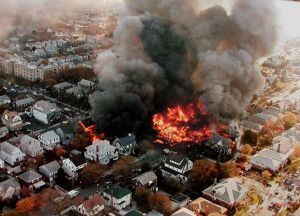Difference between revisions of "American Airlines Flight 587"
(start expand) |
m (archive links) |
||
| Line 21: | Line 21: | ||
==Questions== | ==Questions== | ||
| − | The NTSB report, released in full on December 6, 2004, has a number of issues.<ref>http://usread.com/flight587/Prelim_Report/Part4.html</ref> | + | The NTSB report, released in full on December 6, 2004, has a number of issues.<ref>http://usread.com/flight587/Prelim_Report/Part4.html [https://archive.ph/PoKkG archived]</ref> |
| − | The NTSB conveniently for its narrative ignored the most disturbing aspect of the eyewitness accounts. There were over 70 witnesses who saw the aircraft on fire while it was level–– before it had begun its nosedive. There were at least 27 witnesses who saw the aircraft explode or on fire before the tail separated. <ref | + | The NTSB conveniently for its narrative ignored the most disturbing aspect of the eyewitness accounts. There were over 70 witnesses who saw the aircraft on fire while it was level–– before it had begun its nosedive. There were at least 27 witnesses who saw the aircraft explode or on fire before the tail separated.<ref name=usreadfinal/> |
| − | The NTSB failed to make a professional debris search and proper accounting, or a a map tracing of the aircraft's disintegration. One retired NTSB Senior Air Safety Investigator (ASI) told [[U.S.Read]]: "In the case of AA 587, the NTSB did not even lay out a wreckage trail diagram. This is a basic procedure that is performed when any aircraft is shedding parts, like AA 587 was doing". <ref>http://usread.com/flight587/Prelim_Report/Parts2n3.html</ref> | + | The NTSB failed to make a professional debris search and proper accounting, or a a map tracing of the aircraft's disintegration. One retired NTSB Senior Air Safety Investigator (ASI) told [[U.S.Read]]: "In the case of AA 587, the NTSB did not even lay out a wreckage trail diagram. This is a basic procedure that is performed when any aircraft is shedding parts, like AA 587 was doing". <ref>http://usread.com/flight587/Prelim_Report/Parts2n3.html [https://archive.ph/YWWHE archived]</ref> |
| − | When confronted with specific debris, the NTSB in addition to not mapping the locations they were retrieved from, refused to accept the possibility they could have departed in-flight, especially when it came to talk of possible interior debris.<ref>http://usread.com/flight587/FinalReport/default.html</ref> | + | When confronted with specific debris, the NTSB in addition to not mapping the locations they were retrieved from, refused to accept the possibility they could have departed in-flight, especially when it came to talk of possible interior debris.<ref name=usreadfinal>http://usread.com/flight587/FinalReport/default.html [https://archive.ph/oVkX0 archived]</ref> |
==Aftermath== | ==Aftermath== | ||
Latest revision as of 23:01, 13 April 2022
 | |
| Date | 12 November 2001 |
|---|---|
| Location | New York City, USA |
| Deaths | 265 |
| Description | A catastrophic plane crash in New York City exactly two months and one day after 9-11. |
Exactly two months and one day after 9-11, New York City saw another huge air disaster, but this event has been memory holed. American Airlines Flight 587 was the second-deadliest aviation accident in American history. The plane was flying to the Dominican Republic before suddenly falling out of the sky onto a residential area.
Official narrative
Shortly after take-off from John F. Kennedy International Airport, the plane crashed into the suburban Rockaway Peninsula in Queens, demolishing many houses around the intersection of Newport Avenue and Beach 131st Street in the neighbourhood of Belle Harbor. All 260 people aboard the plane (251 passengers and 9 crew members), as well as one dog in the cargo hold, died in the crash. Five bystanders and one dog on the ground were also killed.[1]
The incident happened only 2 months after 911, and at first was a suspected terrorism incident; later it was officially blamed on pilot error.
The National Transportation Safety Board (NTSB) attributed the disaster to the first officer's overuse of rudder controls in response to wake turbulence from a preceding Japan Airlines Boeing 747-400 that took off minutes before it. According to the NTSB, the aggressive use of the rudder controls by the first officer stressed the vertical stabilizer until it separated from the aircraft. The airliner's two engines also separated from the aircraft before impact due to the intense forces.[2][3]
Questions
The NTSB report, released in full on December 6, 2004, has a number of issues.[4]
The NTSB conveniently for its narrative ignored the most disturbing aspect of the eyewitness accounts. There were over 70 witnesses who saw the aircraft on fire while it was level–– before it had begun its nosedive. There were at least 27 witnesses who saw the aircraft explode or on fire before the tail separated.[5]
The NTSB failed to make a professional debris search and proper accounting, or a a map tracing of the aircraft's disintegration. One retired NTSB Senior Air Safety Investigator (ASI) told U.S.Read: "In the case of AA 587, the NTSB did not even lay out a wreckage trail diagram. This is a basic procedure that is performed when any aircraft is shedding parts, like AA 587 was doing". [6]
When confronted with specific debris, the NTSB in addition to not mapping the locations they were retrieved from, refused to accept the possibility they could have departed in-flight, especially when it came to talk of possible interior debris.[5]
Aftermath
In 2021, looking at Newport Ave & Beach 131 St, Queens, NY 11694, USA on Google Maps, it is impossible to tell that anything ever happened there.
References
- ↑ https://www.ntsb.gov/investigations/AccidentReports/Reports/AAR0404.pdf
- ↑ https://web.archive.org/web/20170430010317/https://www.ntsb.gov/investigations/AccidentReports/Reports/AAR0404.pdf
- ↑ https://web.archive.org/web/20140819125554/http://www.ainonline.com/aviation-news/aviation-international-news/2007-02-01/ntsb-report-aa-587-spreads-blame
- ↑ http://usread.com/flight587/Prelim_Report/Part4.html archived
- ↑ a b http://usread.com/flight587/FinalReport/default.html archived
- ↑ http://usread.com/flight587/Prelim_Report/Parts2n3.html archived